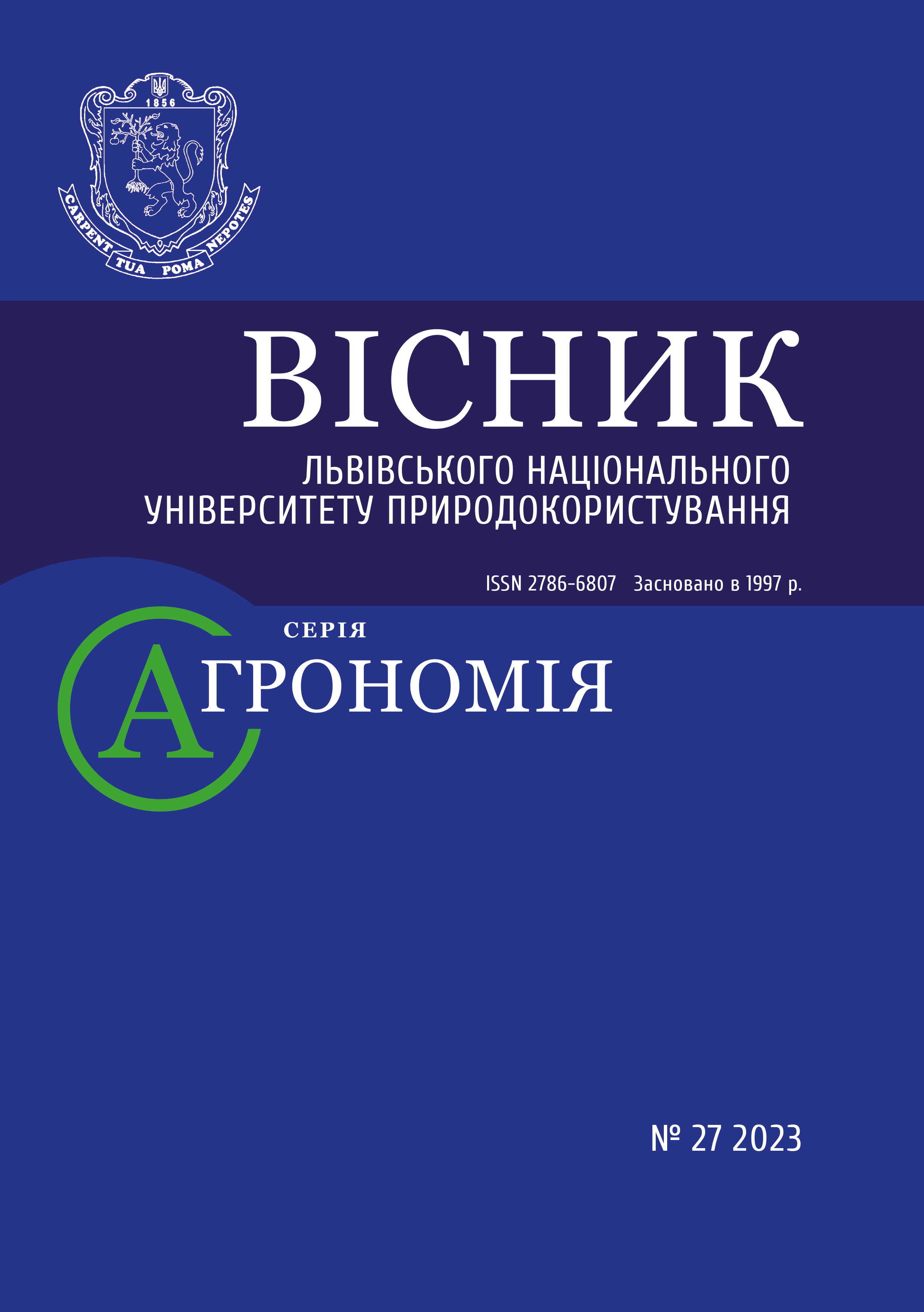IMPACT OF FEEDING PROTECTED VEGETABLE OILS ON THE YIELD AND FATTY ACID COMPOSITION OF COW MILK FAT
DOI:
https://doi.org/10.31734/agronomy2023.27.167Keywords:
calcium salts of fatty acids, sunflower oil, rapeseed oil, lactating cows, milk production, fatty acids of milk fatAbstract
The article presents findings of the research on the impact of feeding calcium salts of fatty acids made from sunflower and rapeseed oil to lactating cows on milk yield and the fatty acid composition of milk fat.
The increased doses of fat supplements, which are used to increase the energy content of the diet, and feeding unsaturated fatty acids, which have a positive effect on the quality of livestock products, negatively influence the ruminal digestion. Protected fats, in particular calcium salts, are used in ruminant diets to reduce the indicated negative impact.
The experiment was conducted during the winter stall period. After the preparatory period, the cows were divided into three groups of five cows each, depending on the average daily milk yield, the number of days after calving, and the number of calvings. During the experimental period, the animals in the first group received a diet without fat additives. The cows of the second group were given calcium salts of fatty acids based on sunflower oil in the amount of 1% of the dry matter of the diet instead of part of the concentrates. The animals of the third group were fed the same amount of calcium salts of fatty acids based on rapeseed oil instead of part of the concentrates.
The introduction of supplements of calcium salts of fatty acids made on the basis of sunflower oil into the diet of dairy cows increases the average daily yield, the amount of milk with basic fat content, the percentage content of fat, protein, and lactose in milk, as well as the yield of fat, protein, and lactose.
Feeding dairy cows with the supplements of calcium salts of fatty acids based on rapeseed oil increases the average daily yield of milk, the amount of milk with basic fat content, the percentage of fat and lactose, and the daily output of fat, protein, and lactose.
The use of calcium salts of fatty acids made basing on sunflower and rapeseed oil in the diet of dairy cows reduces the content of lauric, myristic, palmitic, C14–C16, and saturated fatty acids in milk fat, while the amount of stearic, oleic, and linoleic, as well as C18, unsaturated, and polyunsaturated fatty acids, increases.
References
Amachawadi R. G., Nagaraja T. G. Liver abscesses in cattle: A review of incidence in Holsteins and of bacteriology and vaccine approaches to control in feedlot cattle. J. Anim. Sci. 2016. Vol. 94 (4). P. 1620–1632. doi: 10.2527/jas.2015-0261.
Bayourthe C., Enjalbert F., Moncoulon R. Effects of different forms of canola oil fatty acids plus canola meal on milk composition and physical properties of butter. J. Dairy Sci. 2000. Vol. 83 (4). P. 690–696. doi: 10.3168/jds.S0022-0302(00)74930-7.
Clapperton J. L. Protected fats in ruminant feeding – an update. Feed Compounder. 1986. No 8. P. 27–28.
Digestibility of rumen protected fat in cattle / J. Voigt, S. Kuhla, K. Gaafar, M. Derno, H. Hagemeister. Slovak J. Anim. Sci. 2006. Vol. 39. P. 16–19.
Fats and fatty acids in human nutrition – Report of an expert consultation. 10−14 November 2008. Geneva. Р. 170.
Givens D. I. Milk and meat in our diet: Good or bad for health? Animal. 2010. Vol. 4 (12). P. 1941–1952. doi: 10.1017/S1751731110001503.
Grant R. J., Colenbrander V. F., Mertens D. R. Milk fat depression in dairy cows: Role of silage particle size. J. Dairy Sci. 1990. No 73. P. 1834–1842.
Kurko V. I. Gas chromatographic analysis of food products. Kyiv: Harvest, 1965. P. 65–69.
Palm oil fractionation / M. Kellenc, V. Gibon, M. Hendrix, W. D. Greyt. Eur. J. Lipid Sci. Technol. 2007. Vol. 109. P. 336–349.
Pavkovych S., Vovk S., Kruzhel B. Protected lipids and fatty acids in cattle feed rations. Acta Sci. Pol. Zootechnica. 2015. Vol. 14(3). P. 3–14.
Relation of serum lipoprotein(a) concentration and apolipoprotein(a) phenotype to coronary heart disease in patients with familial hypercholesterolemia / M. Seed, F. Hoppichler, D. Reaveley et al. N. Engl. J. Med. 1990. Vol. 322. P. 1494–1499.
Review: Modulating ruminal lipid metabolism to improve the fatty acid composition of meat and milk / P. G. Toral, F. J. Monahan, G. Hervás et al. Challenges and opportunities. Animal. 2018. P. 1–10.
Vovk S. O., Pavkovych S. Ya. Protected lipids and fatty acids in the diets of cattle. Bull. Agric. Sci. 2016. No 4. P. 48–51.
Waste fat biodegradation and biomodification by Yarrowia lipolytica and a bacterial consortium composed of Bacillus spp. and Pseudomonas putida / M. Tzirita, S. Papanikolaou, A. Chatzifragkou, B. Quilty. Engineering in Life Sciences. 2018. P. 1–29.


